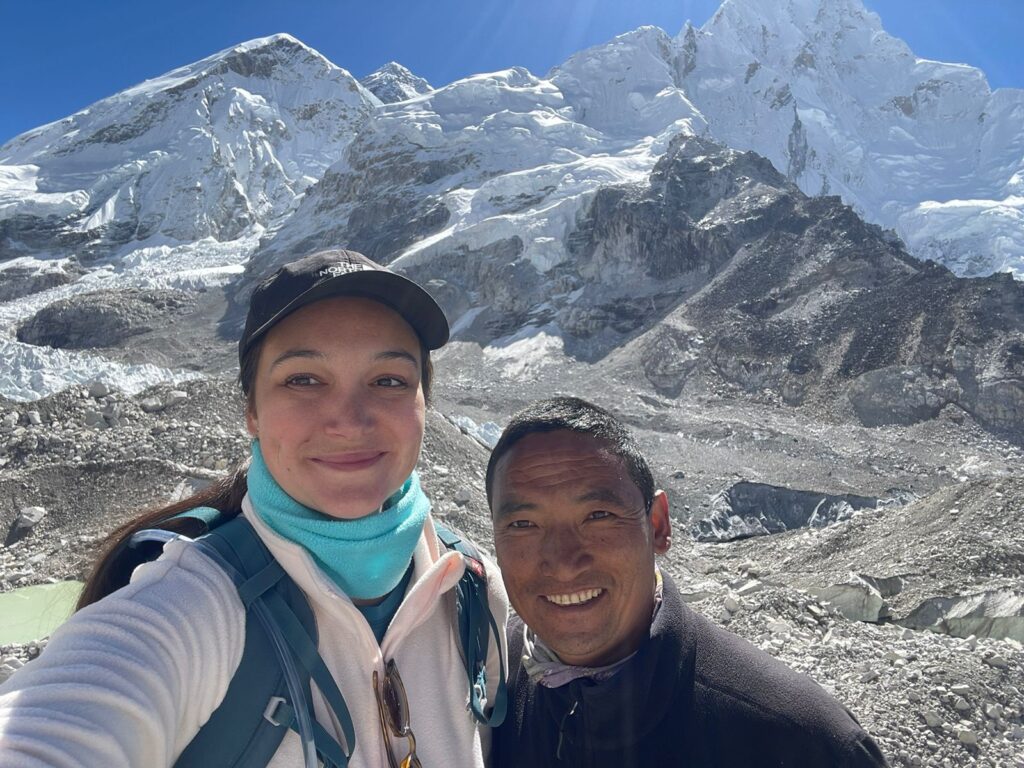
Details of difficult and hard is Everest Base Camp Trekking
Everest Base Camp trek is an enjoyable adventure amidst beautifully landscaped scenery. The hardness of walking and difficulties solely depend upon one fitness level and health conditions. On booking the Everest Base Camp, trekkers should be aware of the Nepal Himalayan landscapes and terrains. The path is full of ups and downhills the higher you reach, rewarded with the best views of the surrounding giant snow-capped peaks.
By walking slower and having short refreshing stops, enjoy the views and observe the local cultures. Which will make Everest Base Camp treks more enjoyable and exciting, as well as feeling in high spirits.
Everest Base Camp Trekking, the grade is from moderate to adventurous due to the high altitude and thin air. The first part of the trek is moderate, following the gradual winding trails, starting from Lukla Town. Although the path leads to short steep and downs, more or less, the walk leads to a pleasant path.
Along the trails, enjoy the stunning vista of the surrounding lovely landscapes, the rolling green hills, and snow mountains. For the first few days, the trail follows through the cool forest covered in tall rhododendrons, oaks, pines, and fir trees.
Make the walk delightful to reach designated overnight stops in the comfort of the nice local lodge. The walking gets harder as you head high areas with the gain in altitude. Following the instructions, of the guide and group leaders will be the best to overcome the difficulty.
The hard section of this trek to Everest Base Camp is the rise of elevations on each day of walking. Everest Base Camp Trekking trails are one of the straight-forward routes than other off-the-beaten tracks.
Best Seasons and Choosing the standard general Itinerary:
To enjoy the Everest Base Camp Trekking, in the first place of your plan. Check for the standard and General Itinerary provided by the concerned trekking agencies, either abroad or with the companies of Nepal, where the fixed departures should be according to your liking and duration of trekking. Choosing the best time of the season makes the adventure to Everest Base Camp Trekking much more enjoyable. Besides the duration and the length of walking hours, from one place for the overnight stops. Around the Himalayas, and for Everest Base Camp Trekking, there are two best seasons to choose from. The spring starts from March to May, and the next best time is autumn/fall, from September to November. The springtime is lively when wildflowers are in seasonal bloom around the high green hills up to Tengboche. Days are longer with sunlight hours and can cover more distance according to the itinerary days.
But cold morning, late afternoon, and nighttime with extra wind-chill factors. Expect snowfall during the spring season en route to Everest base camp and above at 3,000 m. The autumn or fall is another high and peak season for trekking around the Himalayas and Everest Base Camp. Most days are crystal clear with blue sky, a pleasant time for treks and views. But the sunlight hours are much shorter and get dark soon, so you need to check the distance of walking hours.
During autumn, cold morning temperatures and late afternoon, including nighttime. Can get snowfall sometimes, on treks to Everest Base Camp, but it is one of the best times to enjoy the adventures. For interested people who want to avoid the mass flow of trekkers during the high time of spring and autumn seasons. Can also enjoy the Everest Base Camp Trekking during winter times as well.
From December to February, coming across fewer trekkers, most days are fine and clear. The morning, late afternoon, and nighttime with freezing temperatures but with a bright and starry night sky. The cold wind is another factor that makes walking hard, especially during the afternoon. Around, the exposed and open terrains, where trekkers need to be well-equipped against the windy and cold afternoon.
Besides the seasons to choose, the treks to Everest Base Camp and the itinerary days. It should be flexible with rest days to support acclimatization before reaching higher ground. As well as with moderate walking hours of a minimum of 4 to a maximum of 6 hours. This makes the treks pleasant, with ample time to observe the surrounding lovely scenery. As well as to explore and experience the impressive cultures of the Sherpa people.
Most trekkers find the treks to Everest Base Camp hard and more difficult due to limited itinerary days. The general and standard itinerary should be 11 nights and 12 days from Lukla to Lukla. Whereas, some companies might offer shorter itinerary days, which makes the walks tough to cope with the high altitude.
The longer the itinerary days, the better and safer to enjoy the delight of Everest base camp trekking. Rather than struggling to reach the designated overnight stops before it gets dark.
The trail conditions to Everest Base Camp Trek:
Everest Base Camp Trekking is not as hard as one can imagine, where the route is well-established. Includes exciting and strong bridges to cross over the fast-flowing glacial rivers. On midways and junctions of the trail, there are signposts for the right direction en route to Everest Base Camp.
The trails are well-defined, making it easier for the trekkers to choose the right direction to Everest Base Camp. The trail is good and wider for walking, only in a few sections above the rivers, the paths are narrow. But more or less it is safe for easy walking, the only tough climb is up to Namche Bazaar. The trail leads on an undulating steep uphill covering an altitude of more than 500 meters.
After walking from the river bed, which is at approx.2,880 m high, heading slowly, and with enough frequent stops. Will reach you overnights halts, similarly, the other steep climb is up to Tengboche Monastery.
Start the climb slowly to avoid being breathless, and stop whenever you feel tired. The surrounding views will also make the climb easier to enjoy the lovely scenery at every rest stop. The next hard walk is to Everest base camp, but by then, all trekkers will be in good physical shape. To encounter the challenges, but not much difficulty, except for walking on a moraine of rocks, ice, and glaciers.
The last hard is climbing to Kalapathar rocky ridge, the famous and popular viewpoint for the close vista of Mt. Everest. Kalapatthar is the highest point of the adventure, rewarding astounding views of the surrounding giant mountain range.
Conclusion on hard and difficult in Everest Base Camp Treks:
Worldwide travelers interested in Everest Base Camp trekking & Everest Short Trek will certainly enjoy the exciting adventure of a lifetime experience. Stand on the foot of the world’s highest Mt. Everest, amidst the dramatic location of towering giant mountains.
Mt. Everest base camp is regarded, as one of the best and most popular adventure destinations. To reach the target, however, trekkers have to face some hardness and difficulties, as well as the high altitude and the thin air.
Including the rugged terrains to encounter on the last phase of the journey. After overcoming all the factors, walking slowly and steadily and with a positive attitude. In the end, one will be glad and feeling in high spirits, standing beneath the rooftop of the world. As well as exploring beautiful villages adorned with age-old heritage culture. In the close harmony of the majestic Himalayas and within the shadows of Mt. Everest.






